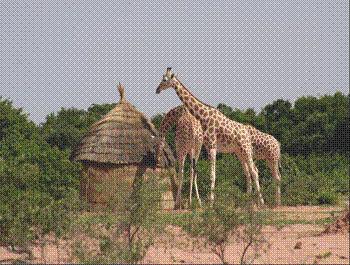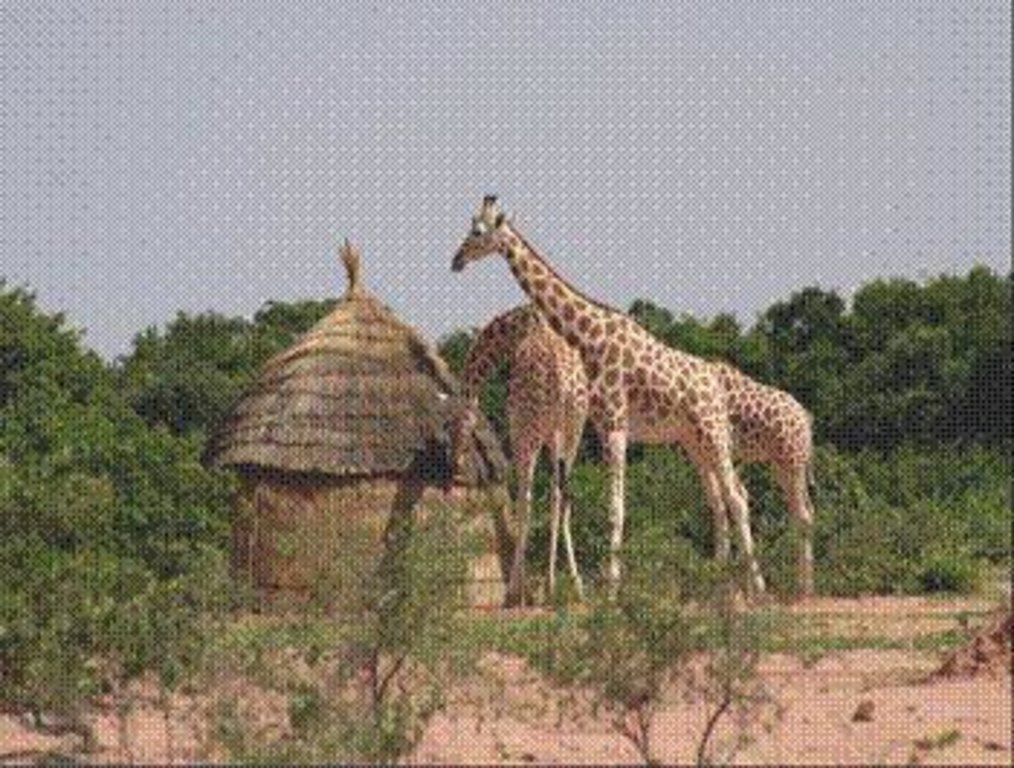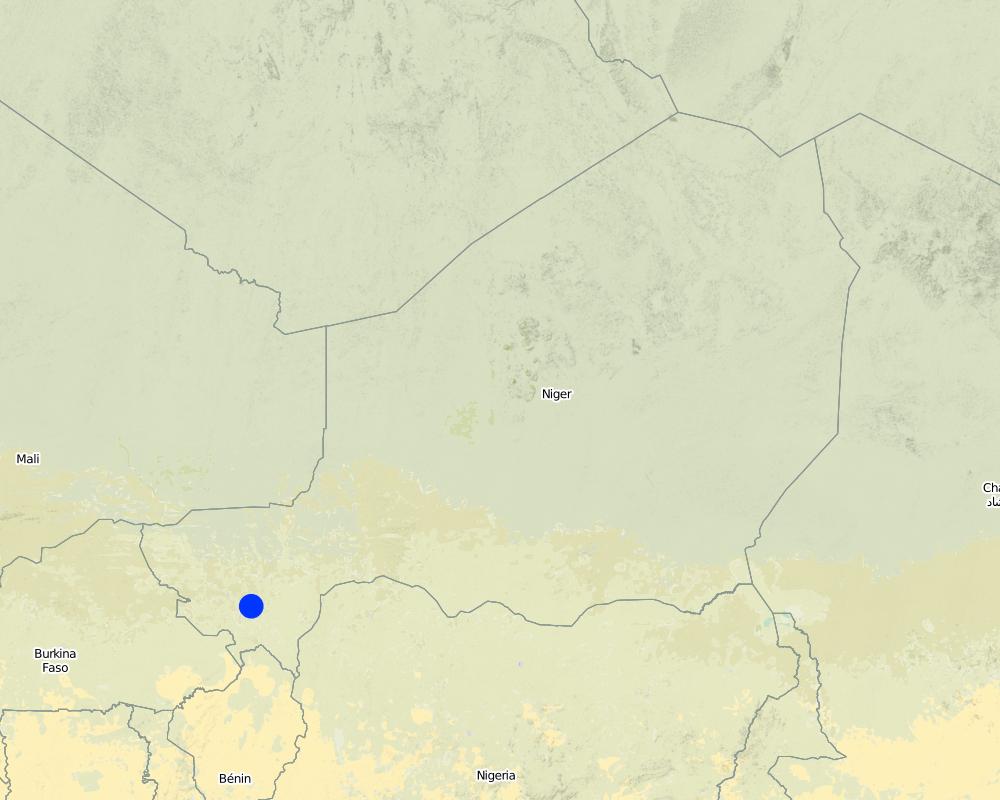Conservation Approach for Kouré Giraffes [ប្រទេសនីហ្សេ]
- ការបង្កើត៖
- បច្ចុប្បន្នភាព
- អ្នកចងក្រង៖ Soumaila Abdoulaye
- អ្នកកែសម្រួល៖ –
- អ្នកត្រួតពិនិត្យ Fabian Ottiger
approaches_2568 - ប្រទេសនីហ្សេ
ពិនិត្យមើលគ្រប់ផ្នែក
ពង្រីកមើលទាំងអស់ បង្រួមទាំងអស់1. ព័ត៌មានទូទៅ
1.2 ព័ត៌មានលម្អិតពីបុគ្គលសំខាន់ៗ និងស្ថាប័នដែលចូលរួមក្នុងការវាយតម្លៃ និងចងក្រងឯកសារនៃវិធីសាស្ត្រផ្សព្វផ្សាយ
អ្នកជំនាញឯកទេស SLM:
Oumarou Ahmed
Ministry of Environment, Niger
ប្រទេសនីហ្សេ
ឈ្មោះអង្គភាពមួយ (ច្រើន) ដែលបានចងក្រងឯកសារ/ វាយតម្លៃលើវិធីសាស្ត្រផ្សព្វផ្សាយ (បើទាក់ទង)
GREAD (GREAD) - ប្រទេសនីហ្សេឈ្មោះអង្គភាពមួយ (ច្រើន) ដែលបានចងក្រងឯកសារ/ វាយតម្លៃលើវិធីសាស្ត្រផ្សព្វផ្សាយ (បើទាក់ទង)
Ministry of Environment and Sustainable Development of Niger (MINEDD) - ប្រទេសនីហ្សេ1.3 លក្ខខណ្ឌទាក់ទងទៅនឹងការប្រើប្រាស់ទិន្នន័យដែលបានចងក្រងតាមរយៈវ៉ូខេត
អ្នកចងក្រង និង(បុគ្គលសំខាន់ៗ)យល់ព្រមទទួលយកនូវលក្ខខណ្ឌនានាទាក់ទងទៅនឹងការប្រើប្រាស់ទិន្នន័យដែលបានចងក្រងតាមរយៈ វ៉ូខេត:
បាទ/ចា៎
2. ការពណ៌នាអំពីវិធីសាស្ត្រផ្សព្វផ្សាយ SLM
2.1 ពណ៌នាសង្ខេបខ្លីពីវិធីសាស្ត្រផ្សព្វផ្សាយ
This participatory approach to protect the last population of white giraffes actively involves local people in conservation activities, while simultaneously strengthening local development and promoting ecotourism.
2.2 ពណ៌នាលម្អិតពិវិធីសាស្ត្រផ្សព្វផ្សាយ
ពណ៌នាលម្អិតពិវិធីសាស្ត្រផ្សព្វផ្សាយ:
Aims / objectives: The giraffe population in Kouré, Niger is unique because: (1) it includes the last representatives of white giraffes (Giraffa camelopardalis peralta) worldwide; (2) it thrives in an unprotected environment without any natural enemy (besides man); (3) it is in direct contact with rural communities and its livestock. The giraffe, reduced to only 49 individuals in 1996, was in danger of extinction due to a variety of reasons, the main one being the progressive deforestation in their habitat: the brousse tigré savannah vegetation. From 1996-2000, a government programme funded by international development agencies (SNV*, FFEM and the EU) has been carried out to sustainably protect the giraffes and their habitat. This program is based on a participatory approach which actively involves local people in conservation activities, while simultaneously strengthening local development and promoting ecotourism. Its revenues are redistributed to all local actors. A main pillar of the approach was the transfer of responsibilities in natural resources management to local organizations. User groups, a guides’ association, a project steering committee, etc. were formed and its members were trained.
Methods: Tourism and wildlife observation infrastructure was established – including a visitor’s centre, lodging, watch towers, etc – and tourism activities were organized: Guides are trained, registered and organized into an association. They receive a fixed salary and accompany tourists in turns. Furthermore they support project technicians and researchers in monitoring giraffes and collaborate with the network of government-employed foresters, which has been set up to control the conservation of the habitat. Tourists pay an entry fee for wildlife watching tours. The revenues and donations are partly used for management and conservation of the giraffe habitat and partly for socio-economic development of the villages (such as infrastructure projects). These revenues are managed directly by the ‘communes’ (municipalities).
Other important information: Thanks to the protection of the savannah vegetation through enclosures for regeneration, prohibition of cutting and closing down of rural wood markets the giraffe population has recovered considerably, comprising 200 individuals in 2008.
2.3 រូបភាពនៃវិធីសាស្ត្រផ្សព្វផ្សាយ
2.5 ប្រទេស/តំបន់/ទីតាំងកន្លែង ដែលវិធីសាស្ត្រផ្សព្វផ្សាយត្រូវបានអនុវត្តន៍
ប្រទេស:
ប្រទេសនីហ្សេ
តំបន់/រដ្ឋ/ខេត្ត:
Tillabéri / Dosso
បញ្ជាក់បន្ថែមពីលក្ខណៈនៃទីតាំង:
Kouré
Map
×2.6 កាលបរិច្ឆេទនៃការចាប់ផ្តើម និងបញ្ចប់នៃវិធីសាស្រ្តផ្សព្វផ្សាយនេះ
សូមបញ្ជាក់ឆ្នាំដែលបានបង្កើតឡើង:
1996
ឆ្នាំបញ្ចប់ (ប្រសិនបើវិធីសាស្ត្រផ្សព្វផ្សាយត្រូវបានឈប់ប្រើប្រាស់):
2000
2.7 ប្រភេទនៃវិធីសាស្ត្រផ្សព្វផ្សាយ
- ផ្អែកលើគម្រោង/កម្មវិធី
2.8 គោលបំណង/ទិសដៅសំខាន់នៃវិធីសាស្ត្រផ្សព្វផ្សាយ
The Approach focused mainly on SLM with other activities (health, education, infrastructure, trade, micro-credit, river works, forest surveillance)
Durable and sustainable conservation of the giraffe population in the Kouré area and protection of their habitat; Building organizational and management capacity of the local population for protecting the giraffes; Fight against poverty by offering supplementary revenue to population through ecotourism (diversification of income).
The SLM Approach addressed the following problems: Conflicts between giraffes and local population (damage to crops); Extinction of giraffes; Deforestation (giraffe habitat deterioration); Rural Poverty; Negative perception of fauna by the population; Absence of titled land ownership and of adapted forestry laws
3. ការចូលរួម និងតួនាទីរបស់ភាគីពាក់ព័ន្ធ
3.1 អ្នកពាក់ព័ន្ធដែលបានចូលរួមក្នុងវិធីសាស្ត្រផ្សព្វផ្សាយ និងតួនាទីរបស់ពួកគេ
- អ្នកប្រើប្រាស់ដីក្នុងតំបន់/សហគមន៍
Women were also involved
- រដ្ឋាភិបាលថ្នាក់មូលដ្ឋាន
- រដ្ឋាភិបាលថ្នាក់ជាតិ (អ្នករៀបចំផែនការ អ្នកសម្រេចចិត្ត)
- អង្គការអន្តរជាតិ
3.2 ការចូលរួមរបស់អ្នកប្រើប្រាស់ដីក្នុងតំបន់/ សហគមន៍ក្នុងតំបន់ក្នុងដំណាក់កាលផ្សេងគ្នានៃវិធីសាស្រ្តផ្សព្វផ្សាយ
| ការចូលរួមរបស់អ្នកប្រើប្រាស់ដីក្នុងតំបន់/សហគមន៍ក្នុងតំបន់ | សូមបញ្ជាក់នរណាត្រូវបានចូលរួម ព្រមទាំងពណ៌នាសកម្មភាពទាំងនោះ | |
|---|---|---|
| ការចាប់ផ្តើម/ការលើកទឹកចិត្ត | គ្មាន | Ministries of planning, environment, tourism and artisan, EU, Association of French Volunteers for Progress (AFVP), SNV, beneficiaries. |
| ការរៀបចំផែនការ | អន្តរកម្ម | Kouré Guides Association (AGK), groups of beneficiaries, project advisors and animators |
| ការអនុវត្តន៍ | អន្តរកម្ម | Kouré Guides Association (AGK), groups of beneficiaries, project advisors and animators |
| ការត្រួតពិនិត្យ និងវាយតម្លៃ | អន្តរកម្ម | AGK, groups of beneficiaries, project advisors and animators, department of Environmental Protection |
| Research | គ្មាន | French Center for Agricultural Research for Development (CIRAD), University of Niamey, National Agricultural Research Institute of Niger (INRAN), International Union for Conservation of Nature (IUCN) and the International Crops Research Institute for the Semi-Arid Tropics (ICRISAT) |
3.4 ការសម្រេចចិត្តលើការជ្រើសរើសបច្ចេកទេស SLM
សូមបញ្ជាក់តើអ្នកណាជាអ្នកបានសម្រេចចិត្តក្នុងការជ្រើសរើសបច្ចេកទេសដើម្បីយកមកអនុវត្តន៍:
- អ្នកនយោបាយ /អ្នកដឹកនាំ
ចូរពន្យល់:
Initiation by the Ministries of planning, environment, tourism and artisan, EU, Association of French Volunteers for Progress (AFVP), SNV, beneficiaries
4. ជំនួយបច្ចេកទេស ការកសាងសមត្ថភាព និងការគ្រប់គ្រងចំណេះដឹង
4.1 ការកសាងសមត្ថភាព/ បណ្តុះបណ្តាល
តើវគ្គបណ្តុះបណ្តាលបានផ្តល់ឱ្យអ្នកប្រើប្រាស់ដី/អ្នកពាក់ព័ន្ធផ្សេងៗទៀតដែរឬទេ?
បាទ/ចា៎
សូមបញ្ជាក់តើអ្នកណាត្រូវបានបណ្តុះបណ្តាល:
- អ្នកប្រើប្រាស់ដី
- បុគ្គលិកចុះទីវាល/អ្នកផ្តល់ប្រឹក្សាយោបល់
ប្រសិនទាក់ទង សូមបញ្ជាក់ ភេទ អាយុ ស្ថានភាពគ្រួសារ ជនជាតិដើមភាគតិច។ល។:
members of community management committee, land users (women and men), professional guides, advisors
ទម្រង់នៃការបណ្តុះបណ្តាល:
- អនុវត្តន៍ជាមួយការងារ
- ពីកសិករទីកសិករ
- ទីតាំងបង្ហាញ
- ការប្រជុំជាសាធារណៈ
- វគ្គបណ្តុះបណ្តាល
ប្រធានបទបណ្តុះបណ្តាល:
Conservation technologies and SLM, ecotourism, professional guide skills, organization of associations, accountancy, agriculture
4.2 សេវាផ្តល់ប្រឹក្សាយោបល់
តើអ្នកប្រើប្រាស់ដីបានទទួលនូវសេវាផ្តល់ប្រឹក្សាដែរ ឬទេ?
បាទ/ចា៎
សូមបញ្ជាក់ប្រសិនបើសេវាកម្មប្រឹក្សាយោបល់ត្រូវបានផ្តល់ឱ្យ:
- នៅលើដីរបស់អ្នកប្រើប្រាស់ដី
ពណ៌នា/ពន្យល់:
Name of method used for advisory service: Dissemination of the approach was by rural animation tools (village planning, rapid PRA, etc.).; The Youth Association for Preservation of Natural Resources (AJPREN), U.S. Peace Corps, AFVP and local departments for Environmental Protection ensured a continuous programme of training, environmental education and awareness raising of guides and local people.
4.5 ការស្រាវជ្រាវ
តើការស្រាវជ្រាវ គឺជាផ្នែកមួយនៃវិធីសាស្រ្តដែរឬទេ?
បាទ/ចា៎
បញ្ជាក់ប្រធានបទ:
- សង្គមវិទ្យា
- សេដ្ឋកិច្ច/ទីផ្សារ
- បរិស្ថានវិទ្យា
សូមផ្តល់ព័ត៌មានបន្ថែមទៀតឱ្យបានលម្អិត និងចង្អុលបង្ហាញនរណាដែលបានធ្វើការស្រាវជ្រាវ:
Research had been conducted on-farm in collaboration with local populations. Research topics treated were socio- economical, ecological, technical, giraffe habitat and genetics and agricultural.
Research was carried out on-farm
5. ថវិកា និងសម្ភារៈឧបត្ថម្ភពីខាងក្រៅ
5.1 ថវិកាប្រចាំឆ្នាំសម្រាប់ផ្សព្វផ្សាយ SLM
ប្រសិនបើចំនួនពិតប្រាកដនៃថវិកាប្រចាំឆ្នាំមិនត្រូវបានដឹងច្បាស់ សូមប្រាប់ពីចន្លោះនៃថវិកានោះ:
- 100,000-1,000,000
មតិយោបល់ (ឧ. ប្រភពសំខាន់នៃមូលនិធិ/ម្ចាស់ជំនួយចំបង):
Approach costs were met by the following donors: international (EU, SNV, FFEM): 100.0%
5.2 ការគាំទ្រផ្នែកហិរញ្ញវត្ថុ / សម្ភារៈដែលបានផ្តល់ទៅឱ្យអ្នកប្រើប្រាស់ដី
តើអ្នកប្រើប្រាស់ដីបានទទួលការគាំទ្រផ្នែកហិរញ្ញវត្ថ/សម្ភារៈសម្រាប់ការអនុវត្តន៍បច្ចេកទេសដែរឬទេ:
បាទ/ចា៎
5.3 សូមបញ្ជាក់ពីធាតុចូលត្រូវបានផ្តល់បដិភាគ (រួមទាំងកម្លាំងពលកម្ម)
- សម្ភារៈ
| សូមបញ្ជាក់ ធាតុចូលណាខ្លះដែលបានផ្តល់បដិភាគ | កម្រិតទំហំប៉ុណ្ណា | សូមបញ្ជាក់ពីការបដិភាគ |
|---|---|---|
| ម៉ាស៊ីន | ផ្តល់ហិរញ្ញវត្ថុទាំងស្រុង | |
| ឧបករណ៍ | ផ្តល់ហិរញ្ញវត្ថុទាំងស្រុង | |
- កសិកម្ម
| សូមបញ្ជាក់ ធាតុចូលណាខ្លះដែលបានផ្តល់បដិភាគ | កម្រិតទំហំប៉ុណ្ណា | សូមបញ្ជាក់ពីការបដិភាគ |
|---|---|---|
| គ្រាប់ពូជ | ផ្តល់ហិរញ្ញវត្ថុទាំងស្រុង | |
| ជី | ផ្តល់ហិរញ្ញវត្ថុទាំងស្រុង | |
- ហេដ្ឋារចនាសម្ព័ន្ធ
| សូមបញ្ជាក់ ធាតុចូលណាខ្លះដែលបានផ្តល់បដិភាគ | កម្រិតទំហំប៉ុណ្ណា | សូមបញ្ជាក់ពីការបដិភាគ |
|---|---|---|
| Tourism | ផ្តល់ហិរញ្ញវត្ថុទាំងស្រុង | |
- ផ្សេងៗ
| ផ្សេងៗ (បញ្ចាក់) | កម្រិតទំហំប៉ុណ្ណា | សូមបញ្ជាក់ពីការបដិភាគ |
|---|---|---|
| Village development funds and Giraffe habitat management | ផ្តល់ហិរញ្ញវត្ថុទាំងស្រុង |
ប្រសិនបើកម្លាំងពលកម្មធ្វើដោយអ្នកប្រើប្រាស់ដី តើវាជាធាតុចូលដ៏សំខាន់មួយដែរ ឬទេ:
- ដោយស្ម័គ្រចិត្ត
5.4 ឥណទាន
តើឥណទានដែលបានផ្តល់នៅក្រោមវិធីសាស្ត្រផ្សព្វផ្សាយសម្រាប់សកម្មភាព SLM នេះយ៉ាងដូចម្តេច?
បាទ/ចា៎
សូមបញ្ជាក់លក្ខខណ្ឌ (អាត្រាការប្រាក់ ការសង ។ល។):
repayment conditions: Through village development fund; micro-credit was allocated without interest to women of women groups for agriculture or livestock production. Repayment occurred after six months. After termination of the project, ‘Care International’ continued giving credit however with interest..
6. ការវិភាគរកផលប៉ះពាល់ និងសេចក្តីសន្និដ្ឋាន
6.1 ផលប៉ះពាល់នៃវិធីសាស្ត្រផ្សព្វផ្សាយ
តើវិធីសាស្ត្រផ្សព្វផ្សាយជួយអ្នកប្រើប្រាស់ដីដើម្បីអនុវត្តន៍ និងថែទាំបច្ចេកទេស SLM?
- ទេ
- បាទ/ច៎ា បន្តិចបន្តួច
- បាទ/ច៎ា ជាមធ្យម
- បាទ/ច៎ា បានខ្លាំង
Improved sustainable land management: one director for the planning and management of the giraffe area was appointed.
តើវិធីសាស្ត្រផ្សព្វផ្សាយនេះផ្តល់សិទ្ធិអំណាចដល់សង្គមនិងសេដ្ឋកិច្ចដែលក្រុមមិនទទួលបានផលប្រយោជន៍?
- ទេ
- បាទ/ច៎ា បន្តិចបន្តួច
- បាទ/ច៎ា ជាមធ្យម
- បាទ/ច៎ា បានខ្លាំង
financial support to women for agricultural production
Did other land users / projects adopt the Approach?
- ទេ
- បាទ/ច៎ា បន្តិចបន្តួច
- បាទ/ច៎ា ជាមធ្យម
- បាទ/ច៎ា បានខ្លាំង
Adoption of Approach by other land users / projects: the ECOsystèmes Protégés en Afrique Sahélienne (ECOPAS) project adopted (2002) this approach which became the basis for national planning action for giraffes in Niger.
Did the Approach lead to improved livelihoods / human well-being?
- ទេ
- បាទ/ច៎ា បន្តិចបន្តួច
- បាទ/ច៎ា ជាមធ្យម
- បាទ/ច៎ា បានខ្លាំង
3811 Euros/village had been distributed to the population of 20 villages through village development funds
Did the Approach help to alleviate poverty?
- ទេ
- បាទ/ច៎ា បន្តិចបន្តួច
- បាទ/ច៎ា ជាមធ្យម
- បាទ/ច៎ា បានខ្លាំង
creation of 13 permanent guide jobs; 900 woman developed agriculture production for marketing
6.2 ការលើកទឹកចិត្តចម្បងៗរបស់អ្នកប្រើប្រាស់ដីសម្រាប់ការអនុវត្តបច្ចេកទេស SLM
- បង្កើនប្រាក់ចំណេញ (សមត្ថភាព) បង្កើនអត្រាចំណេញ
- ការចំណាយ/បដិភាគ
- well-being and livelihoods improvement
6.3 សកម្មភាពផ្សព្វផ្សាយដែលប្រកបដោយចីរភាព
តើអ្នកប្រើប្រាស់ដីអាចធ្វើឱ្យមានចីរភាពនូវអ្វីដែលត្រូវបានអនុវត្តន៍តាមរយៈវិធីសាស្ត្រផ្សព្វផ្សាយដែរឬទេ(ដោយពុំមានការគាំទ្រពីអ្នកខាងក្រៅ)?
- បាទ/ចា៎
ប្រសិនបាទ/ច៎ា សូមរៀបរាប់ថាធ្វើយ៉ាងម៉េច:
After the project was terminated, land users continued this approach without external support based on local development organizations, Association pour la Sauvegarde des Giraffes du Niger (ASGN) and Kouré Guides Association (AGK). Since 2002, the research component is being continued by ECOPAS / EU.
6.4 ភាពខ្លាំង/ គុណសម្បត្តិនៃវិធីសាស្ត្រផ្សព្វផ្សាយ
| ភាពខ្លាំង/ គុណសម្បត្តិ/ ឱកាស ទស្សនៈរបស់បុគ្គលសំខាន់ៗ |
|---|
| Populations organization and mobilization |
| Scientific research tools for decision making |
| Economic, financial and ecological impacts |
6.5 ភាពខ្សោយ/ គុណវិបត្តិនៃវិធីសាស្ត្រ និងរកដំណោះស្រាយ
| ភាពខ្សោយ/ គុណវិបត្តិ/ ហានិភ័យក្នុងទស្សនៈរបស់បុគ្គលសំខាន់ៗ | តើបច្ចេកទេសទាំងនោះបានដោះស្រាយបញ្ហាដូចម្តេច? |
|---|---|
| Absence of local and national financial contribution | provide regressive grants and promote endogenous funding of activities |
| Uncontrolled fast growth of giraffe population | transfer of giraffes to other protected habitats in West Africa. |
| Approach resulted from exterior initiatives | awareness raising and environmental education to develop ‘conservation behaviour’ in Niger |
7. ឯកសារយោង និងវេបសាយ
7.1 វិធីសាស្ត្រ/ ប្រភពនៃព័ត៌មាន
- តាមការចុះទីវាល ការស្រាវជ្រាវនៅទីវាល
- ការសម្ភាសន៍ជាមួយអ្នកប្រើប្រាស់ដី
7.2 ឯកសារយោងដែលបានចេញផ្សាយ
ចំណងជើង អ្នកនិពន្ធ ឆ្នាំ ISBN:
Oumarou A. 2006. Elaboration d’une stratégie de conservation à long terme de la girafe au Niger, communication à l’atelier sur les girafes du Niger organisé du 22-24 novembre 2006 à Niamey (Niger) par le Ministère de l’environnement et de la lutte contre la désertification en partenariat avec ECOPAS/Union EuropéenneCompte rendu de l’atelier international sur la cogestion faune sauvage et bétail, organisé par Abdoulaye Sambo Soumaila et Marlis Lindecke, DED Niger et GTZ Eschborn, février 2001
ចំណងជើង អ្នកនិពន្ធ ឆ្នាំ ISBN:
Compte rendu de l’atelier international sur la cogestion faune sauvage et bétail, organisé par Abdoulaye Sambo Soumaila et Marlis Lindecke, DED Niger et GTZ Eschborn, février 2001
ការតភ្ជាប់ និងម៉ូឌុល
ពង្រីកមើលទាំងអស់ បង្រួមទាំងអស់ការតភ្ជាប់
គ្មានការតភ្ជាប់
ម៉ូឌុល
គ្មានម៉ូឌុល





